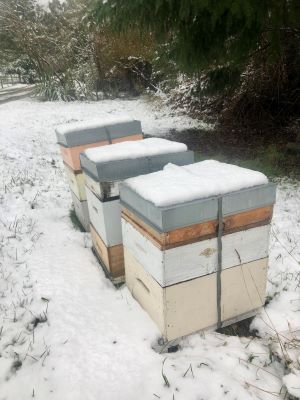Q. I’m a second-year beekeeper, I lost my hives last winter. Should I check my hives in the winter?
A. It depends. Like most things in beekeeping, context is everything. There is the dilemma that going into a hive will actually set it back, but a hive needs to be managed and not going in could mean that critical intervention is missed. We should check our hives to ensure that they are healthy and that they have everything they need.
A colony can’t survive without intervention due to introduced pests and diseases, so we must ensure that mites and disease loads are kept down to manageable levels. Where you live will be important—the upper North Island regularly has warm, sunny winter days, while in the southern South Island the temperatures may stay in single figures for long periods. We should avoid opening a hive when the temperature is below 14°C or when it is raining or too windy—if the bees aren’t flying, don’t go inside. The reason for this is that the brood will get cooled and the pheromones in the hive will dissipate, then the hive must expend energy to get back to pre-inspection levels.
Winter bees are physiologically different than summer bees; they live longer but they aren’t suited to working too hard. Any stress on the bees can affect their immunity, individually and as a colony, making them more susceptible to any disease that may be in the hive but at a previously manageable level.
The trick therefore is ensuring that the hive is healthy and prepared for winter before winter. The three key factors for overwintering are mite levels, adequate stores and a suitable hive. If your mite treatments were successful in late summer and you made sure that mite levels stayed very low in autumn, then they should be OK for winter. Monitoring mite levels is one of the most important tasks for a beekeeper. It can be detrimental to the hive to do a sugar shake test in the middle of winter, but 24- and 48-hour mite drop after oxalic vaporisation can give you both an idea of mite levels and a treatment in one.
Leaving hives enough honey for winter is. by far. best beekeeping practice but getting it right can be difficult, especially with uncertain weather patterns. Autumn feeding is important if stores are down. Bees use most stores in early spring, during the spring build-up. You can heft your hive (lift up one side of the hive to get an idea of its weight) throughout winter to gauge food supplies inside without disturbing the colony.
The hive should be the best home that it can be for the bees—reduce it down to one or two boxes, make sure that the hiveware is sound and is dry with airflow around it. Too much space in the hive is harder to keep warm and dry, harder to defend and the queen mandibular pheromone (QMP) will be more diluted.
Non-invasive hive checks include:watching the bees coming and going for normal behaviour; hefting the hive; natural mite drop; and tapping the side of hive with your ear against it (there should be a loud buzz that quickly settles down). I’ve made Perspex covers for some of my hives. These are useful for doing quick checks, especially of moisture levels, as the covers will show condensation.
My rule of thumb for hobbyists for hive checks is: every 10 days during swarm season; every two to three weeks in summer and every six to eight weeks in winter (if the weather is OK). The first year you’ll check much more often, maybe weekly. This is an important part of your learning and natural curiosity (first-year beekeepers typically go in too often, second year just right and third year not enough).
Ken Brown is an Apiculture Land Based Training tutor, Vice President of the Auckland Beekeepers Club and a keen hobbyist beekeeper.

Hives in North Canterbury winter. Photo: Nick Thorp.
